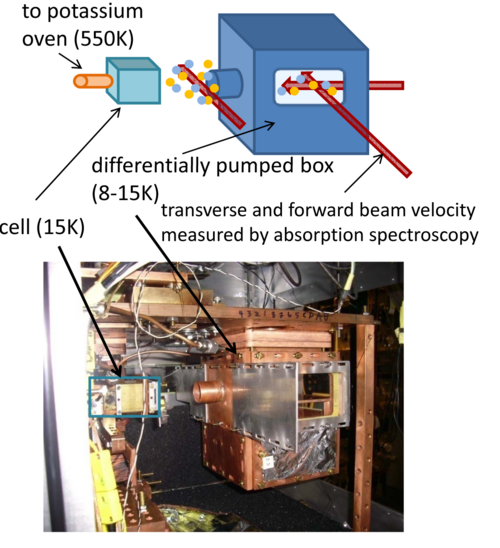Difference between revisions of "BEC"
| Line 12: | Line 12: | ||
The experiment takes place in a G-10 cell, coaxially inside the bore of a 4 T deep superconducting anti-Helmholtz magnetic trap and thermally anchored to a dilution refrigerator. <math>^4</math>He* is excited via RF discharge with an efficiency of <math>10^{-5}</math> from a <math>^4</math>He buffer gas and cooled to the refrigerator temperature by collisions with the remaining buffer gas. The buffer gas is cryo-pumped to a charcoal sorb, leaving ,math>\sim 10^{11} ^4</math>He* atoms trapped in the magnetic field. The atom cloud is then evaporatively cooled to 1 mK by surface-induced evaporation and transferred to a tightly confining superconducting quadrupole-Ioffe configuration trap to prevent Majorana losses. Further evaporative cooling using a RF knife leads to the creation of a BEC at a temperature of 5 <math>\mu</math>K with approximately <math>10^6</math> atoms remaining. | The experiment takes place in a G-10 cell, coaxially inside the bore of a 4 T deep superconducting anti-Helmholtz magnetic trap and thermally anchored to a dilution refrigerator. <math>^4</math>He* is excited via RF discharge with an efficiency of <math>10^{-5}</math> from a <math>^4</math>He buffer gas and cooled to the refrigerator temperature by collisions with the remaining buffer gas. The buffer gas is cryo-pumped to a charcoal sorb, leaving ,math>\sim 10^{11} ^4</math>He* atoms trapped in the magnetic field. The atom cloud is then evaporatively cooled to 1 mK by surface-induced evaporation and transferred to a tightly confining superconducting quadrupole-Ioffe configuration trap to prevent Majorana losses. Further evaporative cooling using a RF knife leads to the creation of a BEC at a temperature of 5 <math>\mu</math>K with approximately <math>10^6</math> atoms remaining. | ||
| − | Since producing our <math>^4</math>He* BEC we have been | + | Since producing our <math>^4</math>He* BEC we have been investigating two-body atom-atom collisional properties of the "submerged-shell" rare-earth atoms Thulium and Erbium. Previous research in our lab indicated that the submerged-shell nature of these atoms gives rise to strong suppression of inelastic processes during atom-helium collisions. Similar suppression of inelastic collisions in atom-atom collisions would permit efficient evaporative cooling and make these atoms excellent candidates for new quantum degenerate gases, accessible using our new buffer-gas BEC approach. |
==Recent Publications== | ==Recent Publications== | ||
| − | *[[Media:A buffer-gas cooled Bose-Einstein condensate, S. C. Doret, C. B. Connolly, W. Ketterle, and J. M. Doyle, to be published by Phys. Rev. Lett. 2009]]. | + | *[[Media:A buffer-gas cooled Bose-Einstein condensate, S. C. Doret, C. B. Connolly, W. Ketterle, and J. M. Doyle, to be published by Phys. Rev. Lett. (2009).]]. |
| − | *[[Media:Evaporative cooling of metastable helium in the multi-partial wave regime, S. V. Nguyen, S. C. Doret, C. B. Connolly, W. Ketterle, and J. M. Doyle, Phys. Rev. A 72 060703(R), (2005)]]. | + | *[[Media:Spin-Exchange collisions of submerged shell atoms below 1 Kelvin, , J.G.E. Harris, S.V. Nguyen, S.C. Doret, W. Ketterle, and J.M. Doyle. Physical Review Letters, 99, 223201 (2007).]]. |
| + | |||
| + | *[[Media:Evaporative cooling of metastable helium in the multi-partial wave regime, S. V. Nguyen, S. C. Doret, C. B. Connolly, W. Ketterle, and J. M. Doyle, Phys. Rev. A 72, 060703(R), (2005)]]. | ||
Revision as of 10:32, 29 July 2009
Buffer-Gas BEC project
People
- Charlie Doret
- Colin Connolly
- Yat Shan Au
Overview
Despite innumerable experimental advances, research with degenerate Bose and Fermi gases has remained limited to only a handful of atomic species since its inception due to the field's reliance on laser pre-cooling as the first step towards quantum degeneracy. Developmening new cooling methods applicable to a wider range of atoms and to molecules is thus an important step towards realizing scientific opportunities in new areas. We have utilized buffer-gas methods to demonstrate Bose-Einstein condensation of <math>^4</math>He* without the use of laser pre-cooling. These methods are readily extendable to any paramagnetic species with typical collisional parameters that allow for efficient evaporative cooling, significantly extending the scope of ultracold atom/molecule research.
The experiment takes place in a G-10 cell, coaxially inside the bore of a 4 T deep superconducting anti-Helmholtz magnetic trap and thermally anchored to a dilution refrigerator. <math>^4</math>He* is excited via RF discharge with an efficiency of <math>10^{-5}</math> from a <math>^4</math>He buffer gas and cooled to the refrigerator temperature by collisions with the remaining buffer gas. The buffer gas is cryo-pumped to a charcoal sorb, leaving ,math>\sim 10^{11} ^4</math>He* atoms trapped in the magnetic field. The atom cloud is then evaporatively cooled to 1 mK by surface-induced evaporation and transferred to a tightly confining superconducting quadrupole-Ioffe configuration trap to prevent Majorana losses. Further evaporative cooling using a RF knife leads to the creation of a BEC at a temperature of 5 <math>\mu</math>K with approximately <math>10^6</math> atoms remaining.
Since producing our <math>^4</math>He* BEC we have been investigating two-body atom-atom collisional properties of the "submerged-shell" rare-earth atoms Thulium and Erbium. Previous research in our lab indicated that the submerged-shell nature of these atoms gives rise to strong suppression of inelastic processes during atom-helium collisions. Similar suppression of inelastic collisions in atom-atom collisions would permit efficient evaporative cooling and make these atoms excellent candidates for new quantum degenerate gases, accessible using our new buffer-gas BEC approach.
